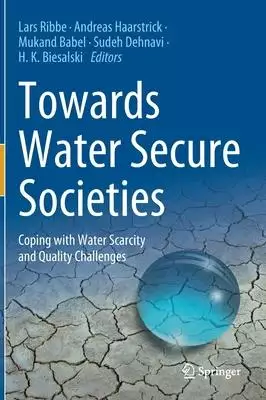Water shortage in Ta的問題,透過圖書和論文來找解法和答案更準確安心。 我們找到下列各種有用的問答集和懶人包
Water shortage in Ta的問題,我們搜遍了碩博士論文和台灣出版的書籍,推薦Benneyworth, Garth寫的 The Battle of Magersfontein: Victory and Defeat on the South African Veld, 10-12 December 1899 和的 Towards Water Secure Societies: Coping with Water Scarcity and Quality Challenges都 可以從中找到所需的評價。
這兩本書分別來自 和所出版 。
中原大學 環境工程學系 江謝令涵所指導 楊于賢的 由再生水系統操作成本及產水水質探討再生水水質標準之最適化 (2021),提出Water shortage in Ta關鍵因素是什麼,來自於再生水、再生水水質標準、再生水推動策略。
而第二篇論文國立臺灣科技大學 化學工程系 何明樺所指導 Tran Vuong Gia Dai的 以3D列印製備含石墨烯之多孔層並應用於太陽能除鹽淨水程序 (2020),提出因為有 Graphene、Desalination的重點而找出了 Water shortage in Ta的解答。
除了Water shortage in Ta,大家也想知道這些:
The Battle of Magersfontein: Victory and Defeat on the South African Veld, 10-12 December 1899

為了解決Water shortage in Ta 的問題,作者Benneyworth, Garth 這樣論述:
Magersfontein is an iconic battle, fought during the South African War of 1899-1902, also known as the Anglo Boer War.Over 30 years of research informs this book, the first ever source referenced history about Magersfontein and other actions, fought in the lead up to this monumental clash between Br
itish and Boer forces. It details the Kimberly Siege and the intensity of combat fought at Belmont, Graspan and, in particular Modder River, an understated yet key battle during the opening months of the war. The history of the Belmont battle is completely re-written, as too Modder River and especia
lly Magersfontein, the focus of this work.No shortage of publications exists on the South African War and Magersfontein. Visits to offline or online bookshops testify, yet myths perpetuate, legends, ideologies, hand down errors, fabrications and sloppy research by self-appointed experts. Contemporar
y sources regurgitate without analysis, and many recent publications offer no references to sources, some proudly so. None consult the rich and extensive archives in the Kimberley and Bloemfontein museums, mostly mimicking each other, using stock standard sources, while ignoring Dutch and Afrikaans
language survivor accounts, resulting in lopsided narratives.To address this historical hole, the author used primary sources, never before published diaries, letters, photographs, maps, battle orders, official histories and reports, personal reflections, regimental histories of the war and survivor
interviews, collected over 30 years. The originals being lodged in archives, libraries, museums and private collections in the United Kingdom, South Africa and Australia.The archive of physical landscape weaves through the written archive. Having walked the killing grounds for over three decades, t
he author’s insights into the archaeology and tangible record speak. Original artillery positions, British infantry, cavalry and Boer commando positions identified by the detritus of battle, as too, forgotten burial sites of human casualties, from all sides.Original findings emerge. At Magersfontein
the Boer forces never excavated a trench from unbroken ground, a mythology debunked. Rather, they adapted a rain water gulley to form a decisive defensive position. Areas of action, which existing narratives glide over, nor mention, include the almost successful British outflanking of Magersfontein
Hill, attacking through the Boer horse lines, the three Boer Defensive Clusters and, importantly, the two Boer counter attacks which broke the Highland Brigade. The Boer forces were mobile participants in winning their victory, not passively parked in trenches, as most narratives present.Insights i
nto military commanders emerge, never before published. Importantly, the war between the Generals, which this work uncovers, relying on unpublished recollections of conversations between senior officers from both sides. The loathing between two prominent Boer generals emerge, as too the incompetence
of the leading British General, glossed over for 122 years. Captured in this infighting, were loyal, efficient and brave British and Boer commanders and ordinary soldiers from both sides. Many of whose voices speak through this narrative for the first time, doing justice and testimony to their uniq
ue, yet terrifying experiences and observations of warfare, in Victory and Defeat on the South African Veld.
由再生水系統操作成本及產水水質探討再生水水質標準之最適化
為了解決Water shortage in Ta 的問題,作者楊于賢 這樣論述:
因國內長期處於自來水水價不合理情況,且再生水水質未有如自來水水質標準般之統一性標準,廠商信任度降低,導致再生水推動困難,且目前再生水推動案,皆由政府媒合廠商,進行水質、水量討論,配合用水端需求設計水質,進而開發再生水廠,其過程繁瑣,因此再生水水質統一,不僅對再生水在市場上競爭力提高,也簡化政府與廠商間媒合過程,降低再生水水價落差,提高廠商使用意願。目前國內規劃之再生水廠,再生水廠處理方式可概略分為三種情況,RO薄膜處理、MBR處理、砂濾處理,因此本研究將設定三種情境,情境A處理流程為「砂濾+UF+RO+消毒」,水質已達純水等級,符合經濟部建議冷卻用水標準,且皆能符合多數廠商之製程用水要求,情
境B處理流程為「曝氣沉沙+A/O+MBR系統+加氯消毒」,情境C處理流程為「砂濾+UV消毒」,情境B、C水質符合經濟部建議冷卻用水標準,但不符合多數廠商之製程用水要求,需廠商額外增設處理設備。本研究透過分析廠商使用三種情境下再生水之社會總花費,以分析國內工業用水量前十名之行業別,加入再生水費用、建設成本、廠商額外處理費用,情境A社會單位成本31.27元/噸,情境B社會單位成本41.93元/噸,情境C社會單位成本29.15元/噸,情境B相比下較不符合經濟效益,情境A與情境C兩者效益接近,可由情境A、C,分別由以下兩種不同角度進行再生水水質標準訂定。參考情境C再生水水質,進行再生水水質標準訂定,最
具有經濟效益,且建設費用最低,可轉而進行其他再生水補貼等政策,唯因水質不符合大多數廠商製程用水要求,廠商須另增設處理設備,在推動再生水初期,可能導致推動緩慢,但缺水風險日益提升,廠商使用意願應會逐漸提升,長期較符合經濟效益。參考情境A再生水水質,進行再生水水質標準訂定,雖效益不及情境C再生水,但其水質能滿足多數廠商,廠商接受度高,在推動再生水初期應較有效率。
Towards Water Secure Societies: Coping with Water Scarcity and Quality Challenges

為了解決Water shortage in Ta 的問題,作者 這樣論述:
Introduction.- Water Security Assessment for the Red - Thai Binh River Basin, Vietnam.- Contextualizing Farmers’ Perceptions of Agricultural Wastewater Reuse in Areas of Water Shortage and Contamination: An In-depth Case Study of Wadi Al-Far a Watershed - Palestine.- Optimize Anaerobic Degradatio
n Processes in Agricultural Wastewater Treatment to maximize Biogas Productivity.- Evaluation of Wastewater Treatment using Dilution in Rosetta Branch and Tala Drain, Nile Delta, Egypt.- Upcoming Challenges of Water Reclamation fromUnconventional Sources.- How Membrane Bioreactor Technology Can Help
to Solve both, German and RussianWastewater Problems.- Experiences on Wastewater Treatment and Reuse for Different Types of Industries.- Social Characteristics and Adaptation to Water Scarcity: The Case of Groundnut Farmers in the Lawra and Nandom Districts, Ghana.- Temporal Climate Variability and
Staple Cereals in Southern Burkina Faso.
以3D列印製備含石墨烯之多孔層並應用於太陽能除鹽淨水程序
為了解決Water shortage in Ta 的問題,作者Tran Vuong Gia Dai 這樣論述:
被動式太陽能除鹽(passive solar-powered desalination)程序因具有節省能源與環境友善等特點,已廣被注意。為求達到最佳的太陽能轉換效率,此程序中的太陽能吸收層應該要在物理與化學特徵上都被妥善設計,然而,發泡或鹽析之類的傳統加工方法並不容易控制太陽能吸收層的結構。在本研究中,我們使用光固化型3D列印精細地設計並製備太陽能吸收層的孔洞結構,探討吸收層構型對能量轉換的影響,此外,也討論石墨烯添加所造成的效應。在第一部分的研究中,我們設計了數種多孔結構,包括直管狀、圓錐狀、鋸齒狀與輪狀結構,各具有受控制的孔洞直徑、孔隙度與線徑,並調整石墨烯的添加量。根據列印結果,含石墨
烯的光固化樹脂在光固化列印中具有高精細度,誤差小於5%,顯示石墨烯/樹脂的混成物有高度可列印性。我們所列印的各種多孔層在自然狀態中可以維持結構與漂浮性超過十七天,代表這些3D列印的光吸收層可以被長時間的使用於除鹽程序中。我們在一個太陽光照的強度下進行揮發測試,結果顯示添加石墨烯能有效促進水揮發效率。比較不同孔洞結構造成的影響,高孔洞曲折度能最有效地提高揮發速率,就本實驗設計的結構而言,錐體結構提升揮發的效果最大,可達到的最高太陽能熱轉化效率達90%。此外,我們也在70oC 與濕度95%的狀態下進行揮發測試,發現多孔光吸收層能維持相同的揮發效率至少24小時,代表在一般環境中可維持其狀態約52天。
本研究證實了多孔結構在揮發除鹽效應中的影響,對製備高效率的太陽能吸收裝置具有相當的幫助。